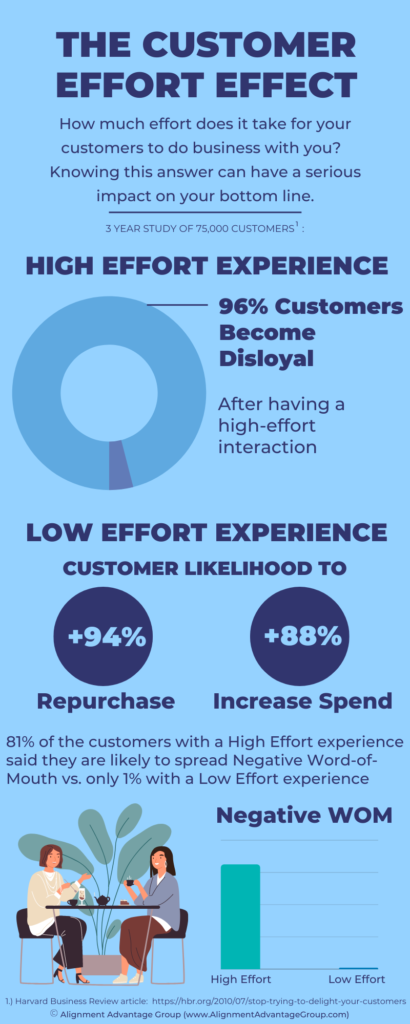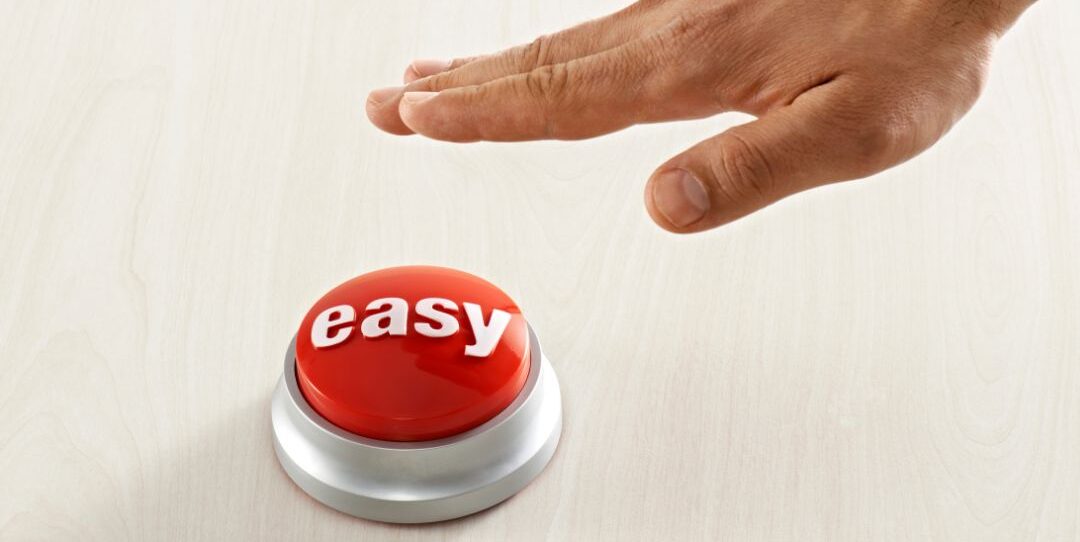If I told you that there is a proven method that you could implement immediately that will increase sales, increase customer retention, and improve your customer satisfaction, without having to invest a bunch of money in new technology, would you be interested?
The Method
The answer is relatively simple – lower your customer’s effort. Make your customer feel that every time they interact with your company it was much easier than they thought it was going to be – like they just hit the “Easy Button,” and all of that can be yours.
The Corporate Executive Board conducted a 3-year, 75,000-people study on what drives customer loyalty and published some of their key findings in the Harvard Business Review. They learned that all of us seriously value hitting the “Easy Button.” Their findings reveal that when we find a company that gives us a low-effort type of experience, we’re more apt to make a purchase, buy more, and come back again to repurchase. They define that as customer loyalty.
The Numbers

Their survey numbers speak for themselves: 88% of the people that had a low-effort experience said they would buy more from that company and 94% said they would repurchase from that company again.
In today’s social media world, customer word-of-mouth can have a serious impact on our brand reputation and subsequent referral business. For customers who reported having a high-effort experience, 81% said they would speak negatively about the company as opposed to only 1% who had a low-effort experience.
Exceeding customer expectations is the primary focus in 89% of the businesses surveyed, but 84% of the customers said they still missed the mark in their most recent service interaction.
Despite all the time, money and effort customer service leaders spend trying to delight the customer, the study found it barely moved the needle in creating customer loyalty compared to lowering the customer’s effort.
The Good News
The good news is that you probably have all you need within your operations today to provide low-effort experiences for your customers. The techniques to deliver low-effort experiences are mainly within your existing staff’s control and they can be trained to generate a low-effort experience for your customers.
The book, The Effortless Experience, written by Matthew Dixon, Nick Toman and Rick DeLisi is a great read on the study and the techniques available to lower your customer effort. Implementing these techniques also drives efficiency, helping your bottom-line.
The Technique
Here are just a few steps you can take to immediately begin reducing your customer effort in your organization:
- None of us like to repeat ourselves. We view that as a high-effort experience. Evaluate your customer journey and find ways to reduce hand-offs or transfers to other departments. This will reduce your customer effort and will improve your First Contact Resolution (FCR). Increasing FCR also has a bottom-line impact to your budget by increasing efficiency and drives cost savings to your company.
- We’re all different. Some of us are more big-picture and some of us like the details. Train your staff techniques to identify and connect with the customer based on the customer’s individual personality type. This resonates with the customer and builds their confidence in the representative, the company, and improves sales.
- Our time is extremely valuable to us. Enhance your staff’s ability to provide proactive service by anticipating the customer’s future needs and avoid unnecessary customer callbacks. As with transfers, this directly impacts FCR and creates efficiency as a bonus to reducing the customer effort.
- Incorporate a Customer Effort Score (CES) into your Customer Satisfaction surveys to measure your results and identify areas of opportunity. For example, asking your customers, on a scale of 1 (strongly agree) to 7 (strongly disagree) how much they would agree with this statement: “This company made it easy to do business with them?” or “This company made it easy for me to resolve my issue?” will give you a wealth of insight into your service and give you a comparative scale you can use with other companies in your industry.
These techniques will also work with your B2B customers to improve your Customer Experience (CEX) and of course, as all ships rise with the tide, will have a direct impact on your Net Promoter Score (NPS). You’ll soon find that the better you get at reducing your customer effort, the more you’ll increase your customer satisfaction, sales, and customer retention.
Create Your Plan
We’d love to help! The Alignment Advantage Group has years of experience working with companies to lower their customer’s effort, improve loyalty, gain efficiency and improve their sales, customer retention and customer satisfaction.
Fill out the form below or call 805-253-2533 to schedule a free collaborative session and learn more about how the Alignment Advantage Group can help!
Book a Free Discovery Call Today!
Schedule a Call Based on Your Schedule
Email or Call: AdamBoelke@AlignAdv.com | (O) 805-253-2533
About the Author: Adam Boelke is an award-winning call center and culture expert with 30+ years of leadership in all areas of contact & call center operations and Managing Partner of the Alignment Advantage Group. The Alignment Advantage Group works with companies just like yours to optimize their operational performance, customer service & employee engagement.
NPS is a registered trademark, and Net Promoter Score is a service mark of Bain & Company, Inc., Satmetrix Systems, Inc. and Fred Reichheld.
© 2022 Written by Adam Boelke, Managing Partner, The Alignment Advantage Group
